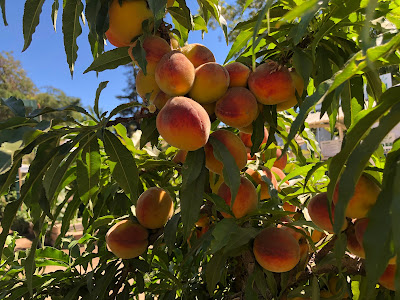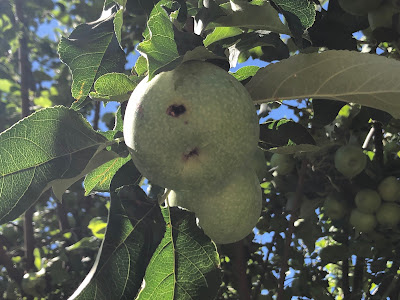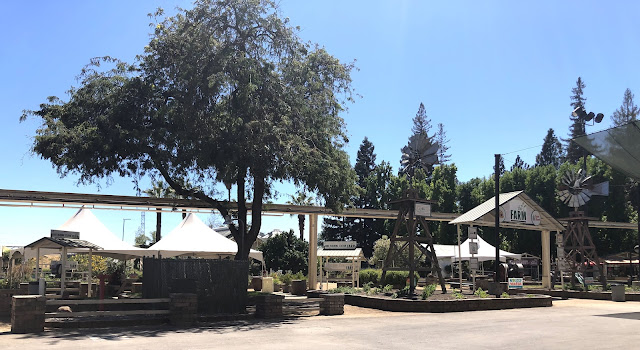
Heat and gardening questions and a sad orchard

|
|
This may look like a great crop, but this miniature
peach tree at the State Fair Farm should have been
thinned before the fruit started to ripen. Branches
are in danger of breaking. (Photos: Kathy Morrison)
|
Been to the State Fair yet this year? It has returned, but in a limited form, shaped by the three tumultuous years since the previous one. (What hasn't changed: Cal Expo is a scorching heat island in the late afternoon. More shade, please, everywhere.)
Back in the Farm area, where the UCCE Sacramento County master gardeners hang out in the open-air answer booth, we see the effects of the pandemic on gardening up close. Apparently because of staffing shortages, the vegetable areas were planted later than usual, so the plants aren't as big as they typically are at this time. No ripe tomatoes this week. The pepper plants aren't filled out. The herbs are not lush. The corn is not as high as an elephant's eye.
Oh, and the myriad weeds are tantalizing certain people (including me) who want to grab a trowel and start digging them out.

|
|
Looks like codling moth damage on this apple tree, which also
needs to be thinned.
|
Because, after all, the master gardeners are there to answer questions and even solve problems, if possible. And at the very least, lend a sympathetic ear.
Two shifts in the Farm booth revealed gardeners' concerns about:
-- Zucchini. It's typically so easy to grow, but it's a problem vegetable this year. Lack of pollination, attacks of whiteflies or squash bugs, and leaves turning yellow were among the question topics. (Probably too much water was the answer to that last one.) Here's a little more on growing squash .
-- Lack of production from vegetables. Beyond zucchini, this is a noticed problem with tomatoes, melons and cucumbers. Blame the heat wave (and lack of humidity) for this: The pollen dries out too fast for the flowers to be pollinated.
-- Vertebrate pests . Squirrels are the least of it, apparently. Rodents and birds are dining extensively on people's vegetables and fruit this summer. Blame the heat and lack of water sources for some of it, use barriers where possible, and try to distract them with bowls of water or seeds away from the growing food.
-- Insect pests. In addition to the whiteflies, the typical summer pests include spider mites, aphids and thrips -- sometimes all on the same plant. Quick hard sprays of water, delivered in the morning on the underside of the leaves, can help fight them. And the water will help also with humidity as it drips into the soil.
-- Planting schedules and plant choices. "Is it too late to plant ...?" got an immediate "yes" in many cases, followed by "it's too hot for baby plants!" Wait til fall, folks, when the heat should subside and planting will be easier on the plants and the gardeners. One foothills couple who asked about growing avocados were told gently that it's not an ideal tree for their region, but hey, citrus does great there! Ever thought of growing mandarins?

|
| Still plenty to see at the Farm at the State Fair, which runs through July 31. |
Comments
0 comments have been posted.Sacramento Digs Gardening to your inbox.
Sites We Like
Garden Checklist for week of April 21
This week there’s plenty to keep gardeners busy. With no rain in the immediate forecast, remember to irrigate any new transplants.
* Weed, weed, weed! Get them before they flower and go to seed.
* April is the last chance to plant citrus trees such as dwarf orange, lemon and kumquat. These trees also look good in landscaping and provide fresh fruit in winter.
* Smell orange blossoms? Feed citrus trees with a low dose of balanced fertilizer (such as 10-10-10) during bloom to help set fruit. Keep an eye out for ants.
* Apply slow-release fertilizer to the lawn.
* Thoroughly clean debris from the bottom of outdoor ponds or fountains.
* Spring brings a flush of rapid growth, and that means your garden is really hungry. Feed shrubs and trees with a slow-release fertilizer. Or mulch with a 1-inch layer of compost.
* Azaleas and camellias looking a little yellow? If leaves are turning yellow between the veins, give them a boost with chelated iron.
* Trim dead flowers but not leaves from spring-flowering bulbs such as daffodils and tulips. Those leaves gather energy to create next year's flowers. Also, give the bulbs a fertilizer boost after bloom.
* Pinch chrysanthemums back to 12 inches for fall flowers. Cut old stems to the ground.
* Mulch around plants to conserve moisture and control weeds.
* From seed, plant beans, beets, cantaloupes, carrots, corn, cucumbers, melons, radishes and squash.
* Plant onion sets.
* In the flower garden, plant seeds for asters, cosmos, celosia, marigolds, salvia, sunflowers and zinnias.
* Transplant petunias, zinnias, geraniums and other summer bloomers.
* Plant perennials and dahlia tubers for summer bloom.
* Mid to late April is about the last chance to plant summer bulbs, such as gladiolus and tuberous begonias.
* Transplant lettuce seedlings. Choose varieties that mature quickly such as loose leaf.